2019 HYUNDAI SONATA HYBRID check engine
[x] Cancel search: check enginePage 491 of 546
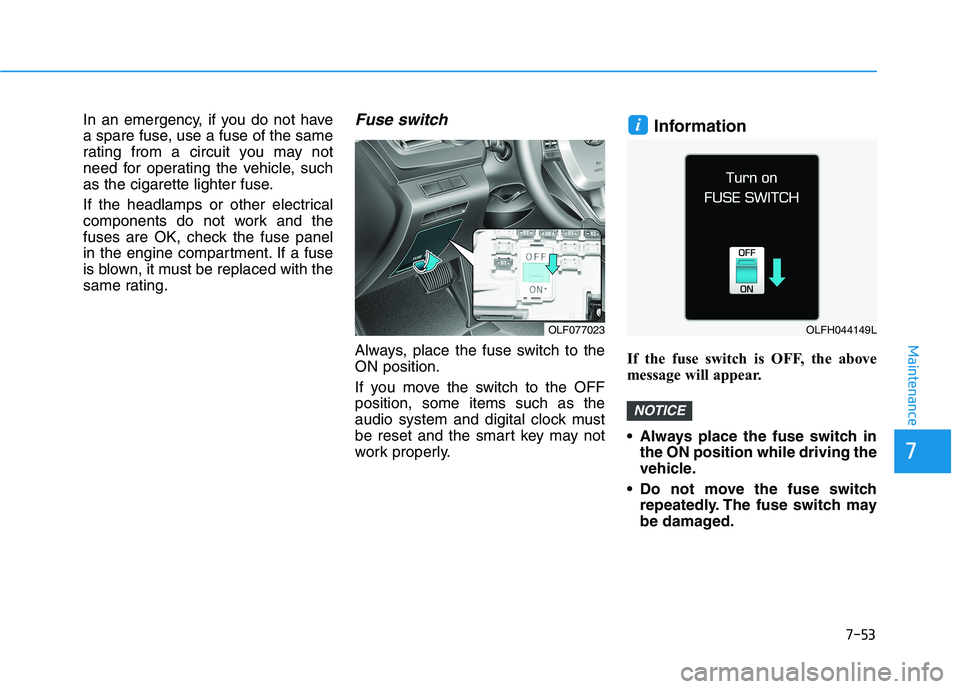
7-53
7
Maintenance
In an emergency, if you do not have
a spare fuse, use a fuse of the same
rating from a circuit you may not
need for operating the vehicle, such
as the cigarette lighter fuse.
If the headlamps or other electrical
components do not work and the
fuses are OK, check the fuse panel
in the engine compartment. If a fuse
is blown, it must be replaced with the
same rating.Fuse switch
Always, place the fuse switch to theON position.
If you move the switch to the OFF position, some items such as the
audio system and digital clock must
be reset and the smart key may not
work properly.Information
If the fuse switch is OFF, the above
message will appear.
Always place the fuse switch in the ON position while driving the
vehicle.
Do not move the fuse switch repeatedly. The fuse switch may
be damaged.
NOTICE
i
OLF077023OLFH044149L
Page 492 of 546
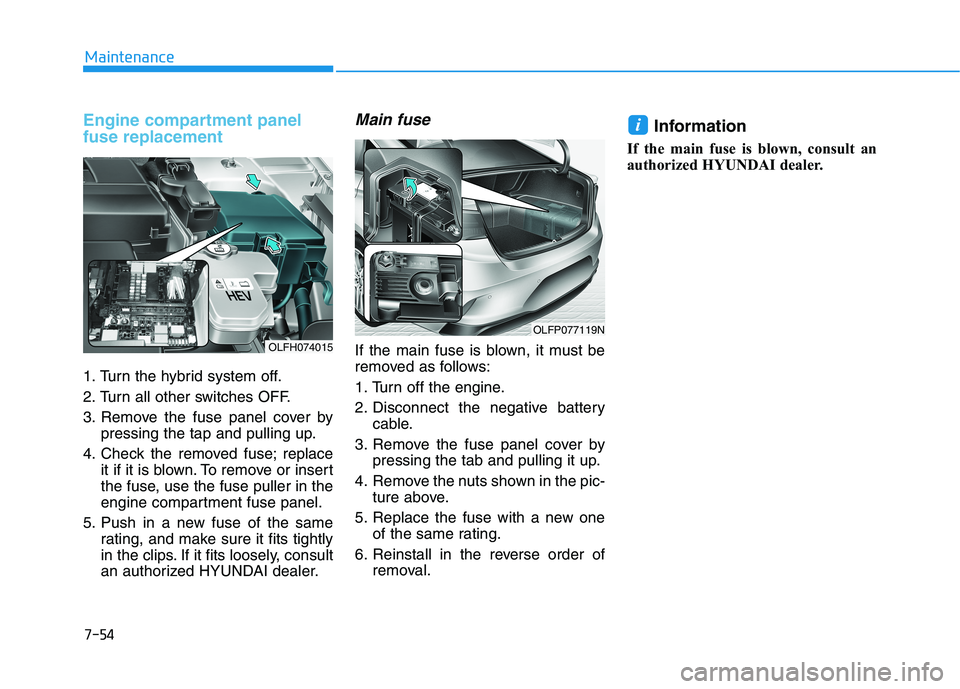
7-54
Maintenance
Engine compartment panel fuse replacement
1. Turn the hybrid system off.
2. Turn all other switches OFF.
3. Remove the fuse panel cover bypressing the tap and pulling up.
4. Check the removed fuse; replace it if it is blown. To remove or insert
the fuse, use the fuse puller in the
engine compartment fuse panel.
5. Push in a new fuse of the same rating, and make sure it fits tightly
in the clips. If it fits loosely, consult
an authorized HYUNDAI dealer.
Main fuse
If the main fuse is blown, it must be
removed as follows:
1. Turn off the engine.
2. Disconnect the negative batterycable.
3. Remove the fuse panel cover by pressing the tab and pulling it up.
4. Remove the nuts shown in the pic- ture above.
5. Replace the fuse with a new one of the same rating.
6. Reinstall in the reverse order of removal. Information
If the main fuse is blown, consult an
authorized HYUNDAI dealer.
i
OLFH074015
OLFP077119N
Page 501 of 546

7-63
7
Maintenance
Engine compartment main fuse panel
Fuse No.Fuse NameFuse RatingCircuit Protected
MULTI FUSE(TYPE A)
IG230APCB Block (IG2 Relay)
BLOWER40ABlower Relay
2AHB40AIntegrated Brake Actuation Unit, Multipurpose Check Connector
1AHB40AIntegrated Brake Actuation Unit, Multipurpose Check Connector
REAR HEATED50ARear Heated Relay
3B+50AIGPM (IPS2 (4CH), IPS3 (4CH), Fuse - STOP LAMP/MODULE 1)
5
B+50APCM Block
(Fuse - WIPER1/HORN/BATTERY C/FAN/AMS/TCU1/ECU2/Engine Control Relay)
EEWP60AElectric Water Pump
MDPS 180AMDPS Unit
MULTI FUSE
(TYPE B)
IG140APCB Block (IG1Relay)
3POWER
OUTLET
40APower Outlet Relay
Page 526 of 546
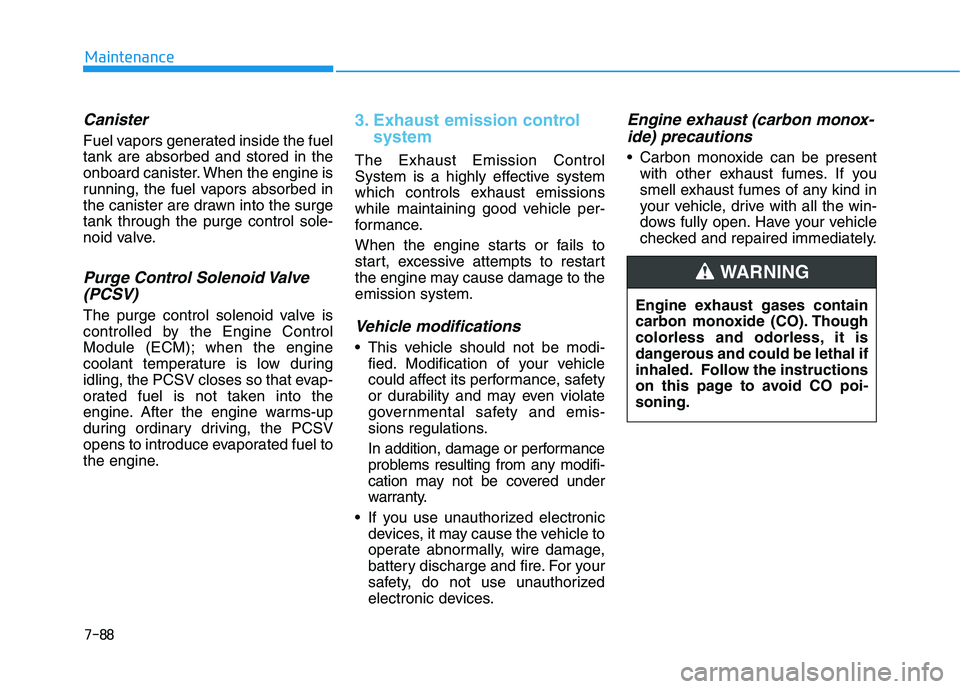
7-88
Maintenance
Canister
Fuel vapors generated inside the fuel tank are absorbed and stored in the
onboard canister. When the engine is
running, the fuel vapors absorbed in
the canister are drawn into the surgetank through the purge control sole-
noid valve.
Purge Control Solenoid Valve(PCSV)
The purge control solenoid valve is
controlled by the Engine Control
Module (ECM); when the engine
coolant temperature is low during
idling, the PCSV closes so that evap-
orated fuel is not taken into the
engine. After the engine warms-up
during ordinary driving, the PCSV
opens to introduce evaporated fuel to
the engine.
3. Exhaust emission control system
The Exhaust Emission Control
System is a highly effective system
which controls exhaust emissions
while maintaining good vehicle per-
formance.
When the engine starts or fails to
start, excessive attempts to restart
the engine may cause damage to theemission system.
Vehicle modifications
This vehicle should not be modi-fied. Modification of your vehicle
could affect its performance, safety
or durability and may even violate
governmental safety and emis-
sions regulations.
In addition, damage or performance
problems resulting from any modifi-
cation may not be covered under
warranty.
If you use unauthorized electronic devices, it may cause the vehicle to
operate abnormally, wire damage,
battery discharge and fire. For your
safety, do not use unauthorized
electronic devices.
Engine exhaust (carbon monox-
ide) precautions
Carbon monoxide can be present with other exhaust fumes. If you
smell exhaust fumes of any kind in
your vehicle, drive with all the win-
dows fully open. Have your vehicle
checked and repaired immediately.
Engine exhaust gases contain
carbon monoxide (CO). Though
colorless and odorless, it is
dangerous and could be lethal if
inhaled. Follow the instructions
on this page to avoid CO poi-soning.
WARNING
Page 535 of 546
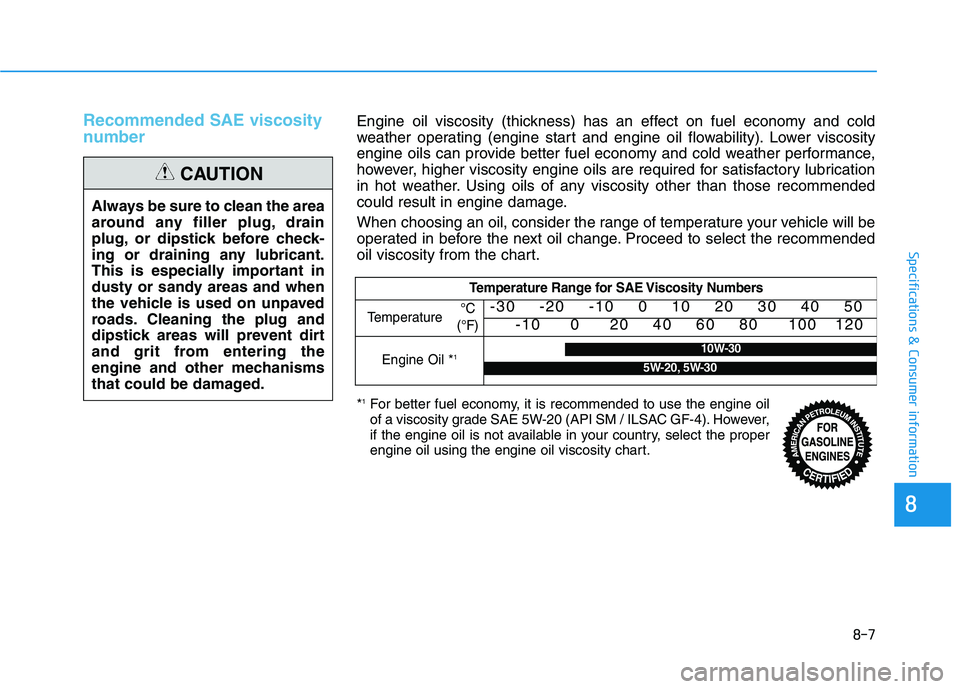
Recommended SAE viscosity
number
Always be sure to clean the area
around any filler plug, drain
plug, or dipstick before check-
ing or draining any lubricant.
This is especially important in
dusty or sandy areas and when
the vehicle is used on unpaved
roads. Cleaning the plug and
dipstick areas will prevent dirt
and grit from entering the
engine and other mechanisms
that could be damaged.
CAUTION
Engine oil viscosity (thickness) has an effect on fuel economy and cold
weather operating (engine start and engine oil flowability). Lower viscosity
engine oils can provide better fuel economy and cold weather performance,
however, higher viscosity engine oils are required for satisfactory lubrication
in hot weather. Using oils of any viscosity other than those recommended
could result in engine damage.
When choosing an oil, consider the range of temperature your vehicle will be
operated in before the next oil change. Proceed to select the recommended
oil viscosity from the chart.
Temperature Range for SAE Viscosity Numbers
Temperature -30 -20 -10 0 10 20 30 40 50
-10 0 20 40 60 80 100 120
Engine Oil *110W-30
5W-20, 5W-30
°C
(°F)
* 1
For better fuel economy, it is recommended to use the engine oil
of a viscosity grade SAE 5W-20 (API SM / ILSAC GF-4). However,
if the engine oil is not available in your country, select the proper
engine oil using the engine oil viscosity chart.
8-7
88
Specifications & Consumer information
Page 541 of 546

I-4
Driver Attention Alert system (DAA) ............................5-62
Resetting the system ...................................................5-64
System malfunction ....................................................5-64
System setting and activation .....................................5-62
System standby...........................................................5-64
Driver position memory system .....................................3-14 Easy Access Function .................................................3-15
Storing Positions into Memory ..................................3-14
Driving the Hybrid/Plug-in Hybrid Vehicle ....................H22
Changing plug-in hybrid mode ...................................H26
Energy flow.................................................................H38
Hybrid System Gauge .................................................H24
Special features ...........................................................H23
Starting the vehicle .....................................................H22
Warning and indicator lights.......................................H27
Warning messages.......................................................H28
Emission control system .................................................7-87 Crankcase emission control system ...........................7-87
Evaporative emission control system including onboard refueling vapor recovery (ORVR) ............7-87
Exhaust emission control system ...............................7-88
Engine ...............................................................................8-2
Engine compartment..................................................1-6, 7-3
Engine coolant/Inverter coolant ......................................7-20
Changing engine coolant ............................................7-23
Checking the engine/inverter coolant level................7-20 Engine number ..................................................................8-9
Engine oil ........................................................................7-18
Checking the engine oil and filter ..............................7-19
Checking the engine oil level .....................................7-18
Engine start/stop button ....................................................5-5
Engine Stop/Start button positions ...............................5-7
Illuminated Engine Start/Stop button ...........................5-6
Starting the hybrid system............................................5-9
Explanation of scheduled maintenance items.................7-15
Exterior features..............................................................3-39 Fuel Filler Door (Hybrid) ...........................................3-46
Fuel Filler Door (Plug-in hybrid) ...............................3-50
Hood ...........................................................................3-39
Smart Trunk ................................................................3-43
Trunk ..........................................................................3-40
Exterior overview (I) ........................................................1-2
Exterior overview (II) .......................................................1-3
Fuses ...............................................................................7-51 Engine compartment panel fuse replacement ............7-54
Fuse/relay panel description .......................................7-56
Instrument panel fuse replacement.............................7-52
Index
E
F
Page 542 of 546
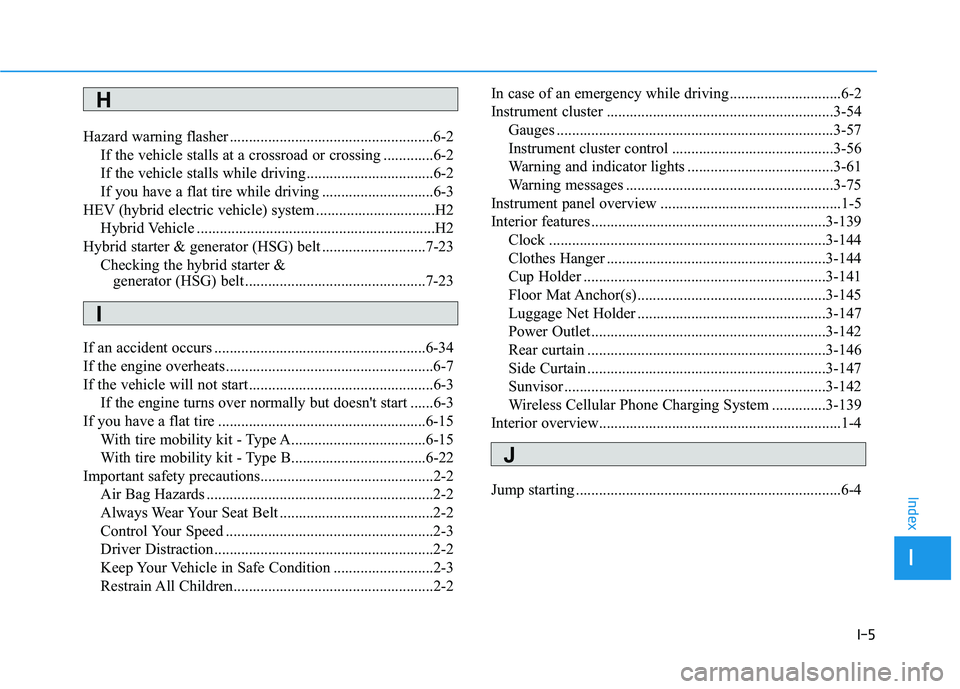
I-5
Hazard warning flasher .....................................................6-2
If the vehicle stalls at a crossroad or crossing .............6-2
If the vehicle stalls while driving .................................6-2
If you have a flat tire while driving .............................6-3
HEV (hybrid electric vehicle) system ...............................H2 Hybrid Vehicle ..............................................................H2
Hybrid starter & generator (HSG) belt ...........................7-23 Checking the hybrid starter & generator (HSG) belt ...............................................7-23
If an accident occurs .......................................................6-34
If the engine overheats ......................................................6-7
If the vehicle will not start ................................................6-3 If the engine turns over normally but doesn't start ......6-3
If you have a flat tire ......................................................6-15 With tire mobility kit - Type A...................................6-15
With tire mobility kit - Type B...................................6-22
Important safety precautions.............................................2-2
Air Bag Hazards ...........................................................2-2
Always Wear Your Seat Belt ........................................2-2
Control Your Speed ......................................................2-3
Driver Distraction.........................................................2-2
Keep Your Vehicle in Safe Condition ..........................2-3
Restrain All Children....................................................2-2 In case of an emergency while driving .............................6-2
Instrument cluster ...........................................................3-54
Gauges ........................................................................3-57
Instrument cluster control ..........................................3-56
Warning and indicator lights ......................................3-61
Warning messages ......................................................3-75
Instrument panel overview ...............................................1-5
Interior features .............................................................3-139 Clock ........................................................................3-144
Clothes Hanger .........................................................3-144
Cup Holder ...............................................................3-141
Floor Mat Anchor(s) .................................................3-145
Luggage Net Holder .................................................3-147
Power Outlet.............................................................3-142
Rear curtain ..............................................................3-146
Side Curtain ..............................................................3-147
Sunvisor ....................................................................3-142
Wireless Cellular Phone Charging System ..............3-139
Interior overview...............................................................1-4
Jump starting .....................................................................6-4
I
Index
H
I
J